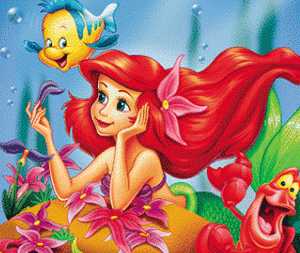Kenversations™
Page 1 of 3

(c) Disney
Return of the Magic
Animation and Disney Rebound
Her Name Was Ariel, She Was a Mermaid
The year was 1989. I can still remember sitting in the theater, watching The Little
Mermaid for the first time. I was in love. I was in love with the film. Sure, it
featured a shallow prince, but it also had Pat Carroll as a campy, nasty witch, Buddy
Hackett as a goofy seagull, and a funny little crab. The songs were upbeat, fun, and
romantic. There was a lovely score, beautiful colors, interesting settings, and most
importantly, a cute gal who could swim and sing.
Yeah, I had a small crush on an animated character. What of it? Okay, it sounds strange to some people. Mark my words, though, that will be more and more common in the future. More on that later. It made sense that I'd fall for Ariel. I had been almost living in water in those days, swimming for recreation and for competition, and I was about the same age as the character. We totally had, like you know, like stuff in common, okay?
I couldn’t get enough of the related merchandise…buttons, posters, plastic figurines, the music…there was a lot of good stuff. At one point, Mickey Mouse was the only other Disney character appearing on more merchandise. I was sure a decent ride-through attraction would have to be built at Disneyland Park, which by then I had been frequenting for years.
The best thing about the film, though, was that it marked the return. The return of the magic - the classic-style Disney animated feature based on a classic fairy tale, complete with great music, magic, princes and princesses, talking animals, and something the whole family could enjoy. For a guy who had grown up on Disney’s versions of such stories as Snow White and the Seven Dwarfs, Sleeping Beauty, Cinderella, Peter Pan, Pinocchio, and Bambi, this was a big deal. The Little Mermaid was just one part of a big year for Disney. And to think it came so close to never happening…
1984 - A Scary Year for Disney
Forget Orwell’s Big Brother. 1984 was a scary time for Disney not because of
totalitarian government, but because of happenings in the mostly free market of corporate
stock trading. Five years before The Little Mermaid hit theaters, Walt Disney
Productions barely survived a hostile takeover attempt that, if successful, would have
likely mean the dismemberment of the corporation.
One possible scenario during that dark time: Corporate raiders gain control of the corporation by buying up shares, which were very low at the time compared to the potential value of the corporation’s assets. The raiders could then sell the Disney assets off in pieces to make a tidy short-term profit on their stock purchase. This could have resulted in Walt Disney World being sold to one company (or, more likely, in pieces to more than one), Disneyland being sold to another, the Walt Disney Studios lot being sold off and leveled, Disney characters being auctioned off individually or sold as group, the library of Disney films being auctioned off or sold as a group, the end of WED Enterprises (now Walt Disney Imagineering) and the end of the animation division. In a matter of weeks, everything Walt Disney, his brother Roy, and their team had built up could have been torn to shreds, the synergistic chain broken, the various divisions treated like siblings separated and put with evil stepparents, exploited until worthless.
However, in the drama that played out, the Disney organization was spared - intact. A new management team from the outside took over, backed by a new group of major shareholders, with a plan to exploit the assets, synergy, and brand name of a unified Disney with a mind for maximizing profits, increasing the value of shares, and growing the corporation. Three key members included: Chairman and CEO Michael Eisner, a veteran of ABC and Paramount; President and COO Frank Wells, veteran of Warner Brothers; and Vice-Chairman Roy E. Disney.
As the story goes, Roy Edward Disney, son of company co-founder Roy Oliver Disney (an older brother of Walt), persuaded the new management to keep the animation team. This would later prove to be a crucial move for the success of the corporation as well as the preservation of its heart.
